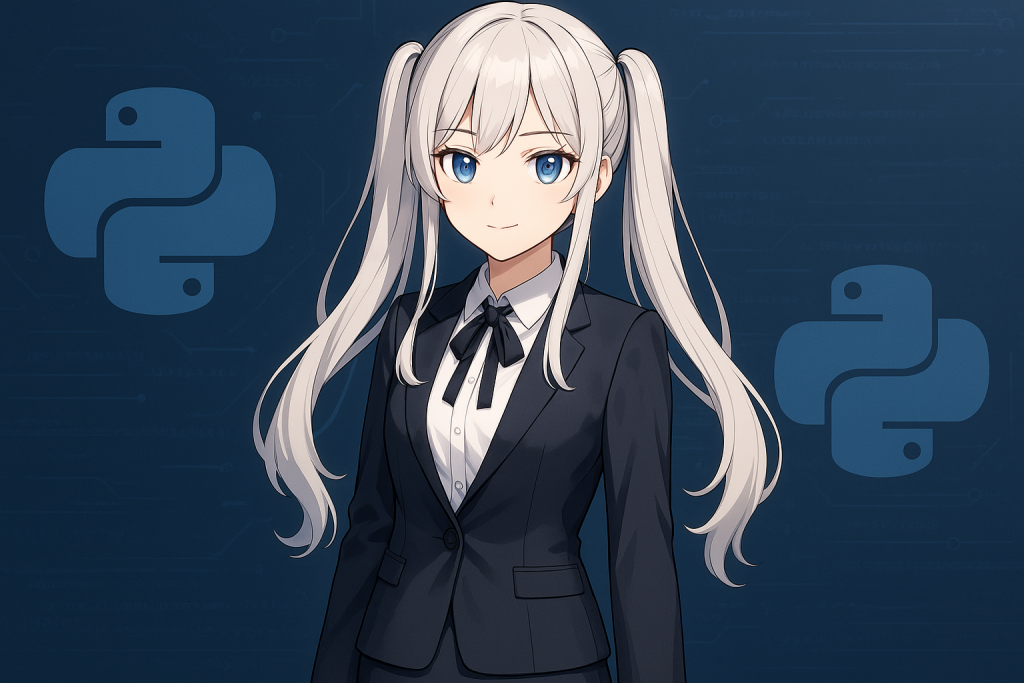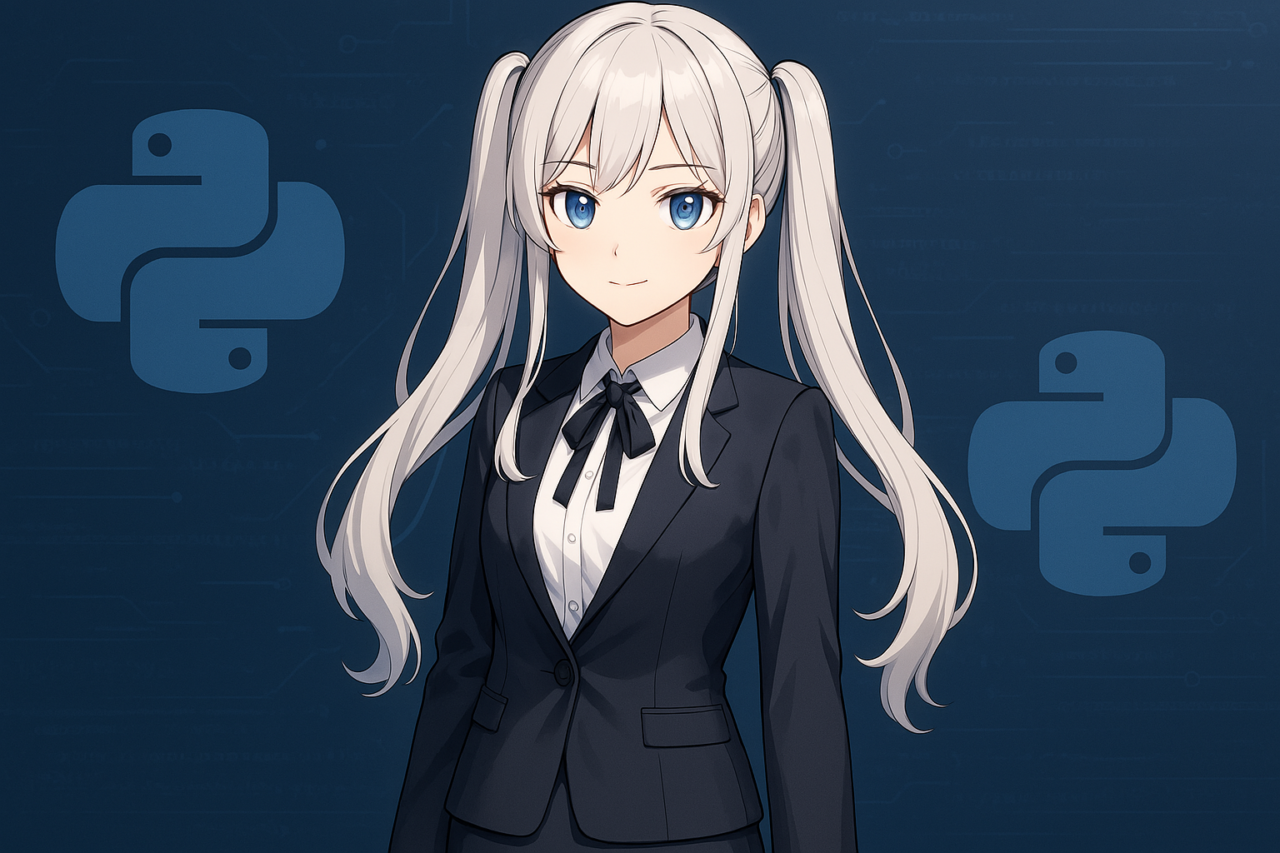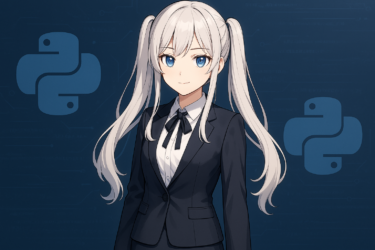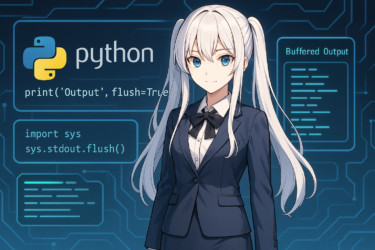- 1 1. Introduction: What is Python?
- 2 2. Differences Between Python and Python 3
- 3 3. Basic Usage of Python 3
- 4 4. Resources for Learning Python 3
- 5 5. Frequently Asked Questions (FAQ)
- 6 6. Summary
1. Introduction: What is Python?
A Programming Language Friendly to Beginners: “Python”
Python is one of the most widely used programming languages around the world. Since it was released in 1991 by the Dutch programmer Guido van Rossum, its simple and readable syntax has been highly praised, and it has come to be widely used from educational institutions to corporate settings.
Python is designed with an emphasis on “readability,” allowing you to write code in syntax close to English. For example, basic operations like conditional branching and loops can be described more concisely compared to other languages, making it a recommended language for programming beginners.
Python’s Fields of Application Are Diverse
Python’s greatest feature is its versatility. It is used in many fields such as the following:
- Web Application Development: Using frameworks like Django and Flask, you can efficiently build websites and APIs.
- Data Analysis and Machine Learning: With libraries like NumPy, pandas, and scikit-learn, it is widely used in data processing and AI fields as well.
- Automation and Scraping: It is suitable for automating daily tasks or collecting information from the web.
- Game Development and GUI Apps: Using PyGame or tkinter, you can also create games and desktop applications.
In this way, Python is a language where “once you learn it, you can do many things.” Therefore, it is adopted not only by engineers but also in non-engineering fields such as marketers and researchers.
Why is Python Gaining Attention?
Currently, Python is particularly popular among many programming languages, and it ranks high in usage on developer platforms such as Stack Overflow and GitHub.
The reasons include:
- Low Learning Cost, Easy for Beginners to Start
- Abundant Libraries and Information Available, Well-Equipped Learning Environment
- High Demand in the IT Industry, Easily Connects to Career Opportunities
such points.
In the future, as fields like AI and data science develop, the demand for Python is expected to increase further.
2. Differences Between Python and Python 3
Python Versions Have Major Branches
Python has multiple versions, but the most important branch is the difference between “Python 2” and “Python 3”. They have incompatible parts in syntax and specifications, which can be a source of confusion for beginners.
Currently, the Python 3 series is mainstream, and official support for the Python 2 series ended in January 2020. If you’re starting to learn now, Python 3 is absolutely recommended.
Main Difference 1: print Syntax
In Python 2, print was used as a “statement” in terms of syntax. On the other hand, in Python 3, it is defined as a “function”.Python 2 example:
print "Hello"Python 3 example:
print("Hello")As such, parentheses are always required in Python 3.
Main Difference 2: String Handling (Unicode)
In Python 2, strings were treated as ASCII by default, but in Python 3, Unicode (UTF-8) is the standard. This makes it easier to develop applications that support multiple languages, such as Japanese.
For example, in Python 2, encoding specifications were often necessary, making issues like garbled text more likely to occur, but in Python 3, such troubles have been greatly reduced.
Main Difference 3: Integer Division Behavior
In Python 2, division between integers returned an integer, but in Python 3, it returns a float.Python 2:
5 / 2 → 2Python 3:
5 / 2 → 2.5In Python 3, the behavior is more intuitive to reduce unintended data type conversion errors.
The Migration to Python 3 Is Already Complete
In the past, there were projects that continued using Python 2 due to library and framework compatibility. However, currently, almost all major libraries support Python 3, and there is no reason to develop with Python 2.
When referencing sample code from the internet for learning, it’s reassuring to check if it specifies “Python 3 compatible”.
If You’re Learning Now, Python 3 Is the Only Choice
In conclusion, for those starting to learn Python or beginning a project, we strongly recommend building your environment and writing code based on Python 3. Knowledge of Python 2 should be kept to a reference level and understood simply as “past specifications”.
3. Basic Usage of Python 3
How to Install Python 3
To start using Python 3, you first need to install it on your computer. Below, we introduce installation methods for major operating systems.
For Windows
- Access the official website (https://www.python.org) and click “Download Python 3.x.x”.
- Launch the downloaded installer.
- Check “Add Python to PATH” and select “Install Now”.
*By adding to PATH, you can launch it simply by typing python in the command prompt.
For Mac
On macOS, Python 2 may be pre-installed, but to use the latest Python 3, it is common to download from the official website or install using Homebrew.
brew install pythonFor Ubuntu/Linux
On Ubuntu and other Linux distributions, you can easily install it using the terminal.
sudo apt update
sudo apt install python3After installation, you can verify it works with python3 or python3 --version.
Let’s Learn the Basic Syntax of Python 3
In Python, the “appearance (indentation)” of the code also carries important meaning. Below, we introduce the basic syntax of Python 3.
Variable Definition and Types
In Python, you can define variables without explicitly specifying types.
name = "Tarō"
age = 25
height = 170.5In this way, you can intuitively use strings (str), integers (int), decimals (float), and so on.
Conditional Branching (if Statement)
if age >= 20:
print("Adult")
else:
print("Minor")Please note that indentation indicates the start of a block.
Looping (for Statement)
for i in range(5):
print(i)In this example, the numbers 0 through 4 are displayed in sequence.
Function Definition
def greet(name):
print("Hello, " + name + "!")
greet("Tarō")In Python, functions are defined using the def keyword.

How to Run Python 3
Python code can be executed in the following two ways.
1. Run in Interactive Shell
By typing python3 in the command line or terminal, Python’s interactive mode starts immediately. You can enter code line by line and check the execution results.
$ python3
>>> print("Hello, Python3!")
Hello, Python3!2. Run as a Script
You can also save it as a .py file and execute it all at once.
# sample.py
print("This is a Python 3 script.")python3 sample.pyEditors for Using Python 3
It is common to use an editor when writing Python. For beginners, the following tools are recommended.
- VS Code (lightweight and feature-rich, with plenty of extensions)
- Thonny (an editor developed for education, very easy to understand)
- Jupyter Notebook (ideal for data analysis and machine learning)
Choose based on your needs or preferences.
4. Resources for Learning Python 3
Leverage Resources That Even Beginners Can Learn From Confidently
Python 3 is used worldwide, so there are abundant learning resources targeting everyone from beginners to advanced users. Here, we introduce representative learning methods and platforms for efficiently learning Python 3.
Utilize Official Documentation
The most reliable source of information is the Python Official Documentation. It is well-maintained with Japanese translations, and it explains language specifications and standard library usage in detail.
However, while the content is comprehensive, it might feel a bit difficult for beginners. It is recommended to use it like a dictionary.
Online Learning Platforms
There are many platforms on the internet that offer systematic courses for beginners.
- Progate: Learn from the basics in slide format, and proceed while actually typing code.
- Dot Install: Tutorials composed of short videos around 3 minutes long. Ideal for learning in spare time.
- Udemy: Paid, but offers many practical courses, and using regular sales makes it cost-effective.
Learn Systematically with Books
Books remain in physical or e-book form at hand, so they are recommended for those who want to solidify the basics thoroughly.
The following are standard books for beginners:
- “Python First Grader” (Shoeisha)
- “Self-Taught Programmer: From Python Basics to Work Methods” (Nikkei BP)
- “Everyone’s Python, 4th Edition” (SB Creative)
All of them support Python 3, and the explanations of environment setup and basic syntax are thorough.
YouTube Channels and Video Courses
For those who prefer video learning, YouTube tutorial videos are also effective.
- Kino Code: Easy to understand in Japanese, centered on practical content.
- Python Programming VTuber Sapoo: VTuber Sapoo explains from Python basics to applications in videos that combine fun and practicality. You can learn while seeing actual code, deepening visual understanding.
Searching for keywords like “Python 3 Introduction” will yield many videos.
Learning Communities and Q&A Sites
Rather than struggling alone, learning while interacting with other learners and experienced people makes understanding easier.
- teratail: A Q&A site where you can ask and answer in Japanese.
- Stack Overflow: A Q&A site where engineers from around the world gather. It’s in English, but the amount of information is overwhelming.
- Qiita: A Japanese blog service where many specific Python usage methods and tips are shared.
If you have any questions, feel free to ask.
Find a Learning Style That Suits You
In learning Python 3, “finding a method that is easy for you to learn” is the key to continuation. People who suit videos, those who want to learn thoroughly with books, those who want to remember by actually moving their hands—it’s fine to proceed with different approaches.
What’s important is the attitude of “try writing and running it first” rather than “proceed after perfect understanding”. While making good use of learning resources, please try tackling it enjoyably.
5. Frequently Asked Questions (FAQ)
Answering Common Questions Beginners Have When Learning Python 3
When you start learning Python 3, everyone encounters similar questions and concerns. Here, we have compiled the points that many beginners often struggle with in a Q&A format.
Q1. Which should I learn, Python or Python 3?
A. You should learn Python 3.Python 2’s official support ended in 2020. All major libraries and frameworks currently in development support Python 3, so Python 3 is the prerequisite for learning from now on.
Q2. Will Python 2 code run on Python 3?
A. Basically, it won’t run, but it may work after corrections.Due to incompatibilities in syntax, string handling, and many other aspects, code written for Python 2 often results in errors when run directly on Python 3. However, using the 2to3 conversion tool can automatically convert some code to Python 3.
Q3. Where can I check the latest version of Python 3?
A. You can always check the latest version on the Python official website.
The current stable version is displayed on the top page, and you can download it from there. The differences in version numbers are mainly minor feature additions and bug fixes.
Q4. What are the benefits of using Python 3?
A. It is a modern, easy-to-understand, and powerful language that supports contemporary development.Python 3 has the following benefits:
- Readable code that is less prone to errors
- Versatile for use in many fields such as data analysis, machine learning, and web development
- Abundant learning resources and a very active community
- Expected to remain in use for a long time
For these reasons, it is widely chosen not only by beginners but also in professional settings.
Q5. Are there any recommended editors for learning Python 3?
A. Yes, there are several user-friendly editors depending on your purpose.
- VS Code: Rich in extensions, with many settings optimized for Python.
- Thonny: A simple and easy-to-use editor designed for beginners.
- Jupyter Notebook: Ideal for data analysis and machine learning. It allows you to manage code, execution results, and notes together.
All of them are free, so try a few and choose the one that suits you best.
6. Summary
Python 3 is an Essential Programming Language for the Future
In this article, we’ve explained the basics of Python and Python 3, their differences, usage, and learning methods for beginners. Python has simple syntax that’s easy to learn, and it’s practical for development right away, making it one of the best choices for those learning programming for the first time.
Also, the current mainstream is Python 3, so if you’re starting to learn, choose Python 3 without hesitation. Python 2’s official support has already ended, and it’s hardly used in the field anymore.
Key Points to Keep in Mind When Learning Python 3
- Understand installation methods and basic syntax carefully
- Use learning resources that suit you, such as books, online courses, and videos
- Value the attitude of trying it out and experimenting first
- If you don’t understand something, look it up or ask questions on communities and Q&A sites
Acquiring Python 3 requires a steady and persistent attitude. Start with simple code and gradually challenge more complex programs.
Move on to the Next Step
Once you’ve mastered the basics, move on to applied fields.
- Web development (Flask, Django)
- Data analysis (pandas, matplotlib)
- Machine learning (scikit-learn, TensorFlow)
- Business efficiency and automation (Excel operations, web scraping, etc.)
By mastering Python 3, you’ll gain a foundation that can be applied to a wide range of technologies. Continue learning and practice in your areas of interest.





